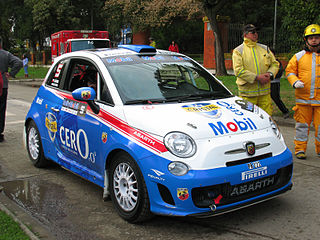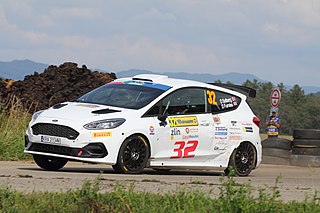Production car racing, showroom stock racing, street stock, pure stock, touring and U-car racing are all categories of auto racing where unmodified production cars race each other, outright and also in classes.

The World Rally Championship is an international rallying series owned and governed by the FIA. Inaugurated in 1973, it is the second oldest of the FIA's world championships after Formula One. Each season lasts one calendar year, and separate championship titles are awarded to drivers, co-drivers and manufacturers. There are also two support championships, WRC2 and WRC3, which are contested on the same events and stages as the WRC, but with progressively lower maximum performance and running costs of the cars permitted. Junior WRC is also contested on five events of the World Rally Championship calendar.
A World Rally Car is a racing automobile built to the specific regulations set by the Fédération Internationale de l'Automobile (FIA) and designed for competition in the World Rally Championship (WRC). The cars were introduced in 1997 as a replacement for Group A regulations used in the manufacturers' championship, and were replaced by Group Rally1 in 2022.

Group A is a set of motorsport regulations administered by the FIA covering production derived touring cars for competition, usually in touring car racing and rallying. In contrast to the short-lived Group B and Group C, Group A vehicles were limited in terms of power, weight, allowed technology and overall cost. Group A was aimed at ensuring numerous entries in races of privately owned vehicles.

Group B was a set of regulations for grand touring (GT) vehicles used in sports car racing and rallying introduced in 1982 by the Fédération Internationale de l'Automobile (FIA). Although permitted to enter a GT class of the World Sportscar Championship alongside the more popular racing prototypes of Group C, Group B are commonly associated with the international rallying scene during 1982 to 1986 in popular culture, when they were the highest class used across rallying, including the World Rally Championship, regional and national championships.

The Group 3 racing class referred to a set of regulations for Grand Touring Cars competing in sportscar racing and rallying events regulated by the FIA. These regulations were active, in various forms, from 1957 to 1981.

Super 2000 is an FIA powertrain specification used in the World Rally Championship, the British Touring Car Championship, the World Touring Car Championship, and other touring car championships. The engines were originally 2 L naturally aspirated, and later being also allowed 1.6 L turbocharged units producing approximately 280 bhp.
In motorsport, homologation is a testing and certification process for vehicles, circuits, and related equipment for conformance to technical standards, usually known as type approval in English-language jurisdictions. It confirms conformity to standards or categorisation criteria typically set by the sporting authority. At international and supra-national level, the FIA and FIM mandate what must be homologated, the FIA in its International Sporting Code and appendices. National sporting authorities such as Motorsport UK must adhere to these rules but may enforce additional or specific homologation rules applicable to their series or jurisdiction, however, unaffiliated series may set their own requirements.
The FIA WRC2 is a support championship of the World Rally Championship (WRC). The calendar consists of the same rallies and stages as the parent series and crews usually compete immediately after Rally1 class crews. WRC2 is limited to production-based cars homologated under Group Rally2 rules. There are separate specific championship titles awarded to Teams, Drivers and Co-Drivers.

In relation to motorsport governed by the Fédération Internationale de l'Automobile, Group R refers to a set of regulations providing production-derived vehicles for rally competition. The Group R regulations were gradually introduced from 2008 as a replacement for Group A and Group N rally cars.

The FIA Production car World Rally Championship, or PWRC, was a companion rally series to the World Rally Championship, contested mainly by Group N rally cars.

Group GT3, known technically as Cup Grand Touring Cars and commonly referred to as simply GT3, is a set of regulations maintained by the Fédération Internationale de l'Automobile (FIA) for grand tourer racing cars designed for use in various auto racing series throughout the world. The GT3 category was initially created in 2005 by the SRO Motorsports Group as a third rung in the ladder of grand touring motorsport, below the Group GT1 and Group GT2 categories which were utilized in the SRO's FIA GT Championship, and launched its own series in 2006 called the FIA GT3 European Championship. Since then, Group GT3 has expanded to become the de facto category for many national and international grand touring series, although some series modify the ruleset from the FIA standard. By 2013, nearly 20 automobile manufacturers have built or been represented with GT3 machines.
In international rallying, Group R-GT, is a formula of rally car defined by the FIA for GT cars introduced in 2011. Between 2014 and 2019 technical passports were issued for individual vehicles built by tuners. Since 2020 R-GT cars are required to be homologated by the manufacturer in common with other rally car formulae.
The FIA Rally Pyramid is the collective description and organisation of championships, car performance classes and driver aptitude in international rallying. In 2019 the FIA rally commission presented a radical overhaul to the rally pyramid to introduce common nomenclature and structure of the international championships and car classes used across the sport in a similar way to terminology used in formula racing. At the top of the pyramid, Rally1 describes elite level of driver aptitude and car performance in the World Rally Championship (WRC). At the foot of the pyramid is Rally5, designed for cost effective introductory rallying competition.

Group Rally1 is a technical specification of rally car for use at the highest level of international rallying in the World Rally Championship (WRC) as determined by the FIA. Despite the use of the word 'Group' in the name, there are not multiple classes or subclasses of car and so 'Rally1' may be used alone with the same definition. Rally1 cars were used for the first time in the 2022 WRC season and replaced the outgoing World Rally Car used in the manufacturer's championship. Though they may run on any individual rally as permitted by the organiser, they are not to be used in any other championship.

Group Rally2 is a technical specification of rally car determined by the FIA. It features 1.6L turbo engines, four-wheel drive and a maximum power-to-weight ratio of 4.2kg/hp. Rally2 cars are used in the World Rally Championship and continental championships; a few national rallying competitions also allow Group Rally2 cars to compete. The group was launched in 2019 with other similarly named groups after the introduction of the Rally Pyramid initiative to reorganise the classes of car and championships in international rallying was approved in June 2018.

Group Rally3 is a technical specification of rally car determined by the FIA. It features four-wheel drive and a maximum power-to-weight ratio of 5.6kg/hp. The class is used in the World Rally Championship (WRC) and regional championships. National rallying competitions also allow Group Rally3 cars to compete. There are three technical subclasses of Group Rally3 however these do not affect competitive eligibility so 'Rally3' may be used alone with the same definition. The group was launched in 2021 with the homologation of the first car after the introduction of the Rally Pyramid initiative to reorganise the classes of car and championships in international rallying was approved in June 2018.

Group Rally4 is a technical specification of rally car determined by the FIA for use in its international competitions: World Rally Championship (WRC) and regional championships. National rallying competitions also allow Group Rally4 cars to compete. There are two technical subclasses of Group Rally4 however these do not affect competitive eligibility. 'Rally4' may be used alone with the same definition. The group was launched in 2019 after the introduction of the Rally Pyramid initiative to reorganise the classes of car and championships in international rallying was approved in June 2018.

Group Rally5 is a technical specification of rally car determined by the FIA for use in its international rallying competitions: World Rally Championship (WRC) and regional championships. National rallying competitions also allow Group Rally5 cars to compete. There are no subclasses of the group therefore all Group Rally5 cars can compete in the same category. 'Rally5' may be used alone with the same definition. The group was launched in 2019 after the introduction of the Rally Pyramid initiative to reorganise the classes of car and championships in international rallying was approved in June 2018.


















